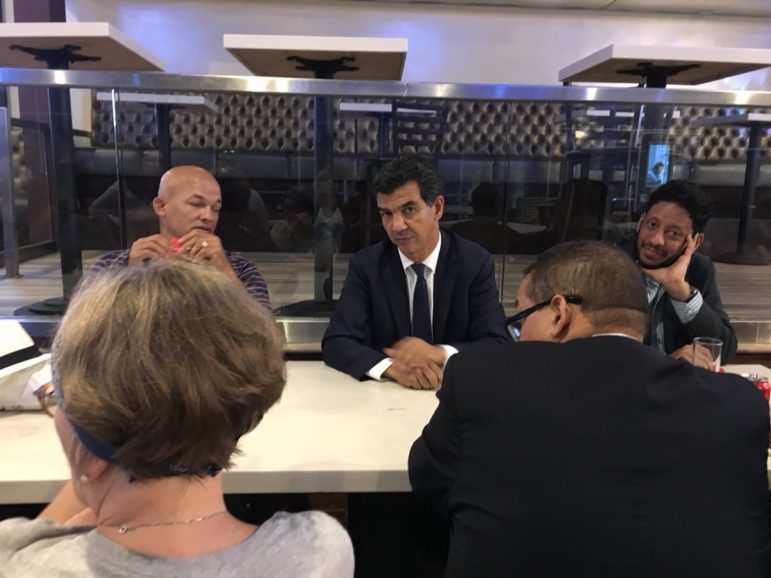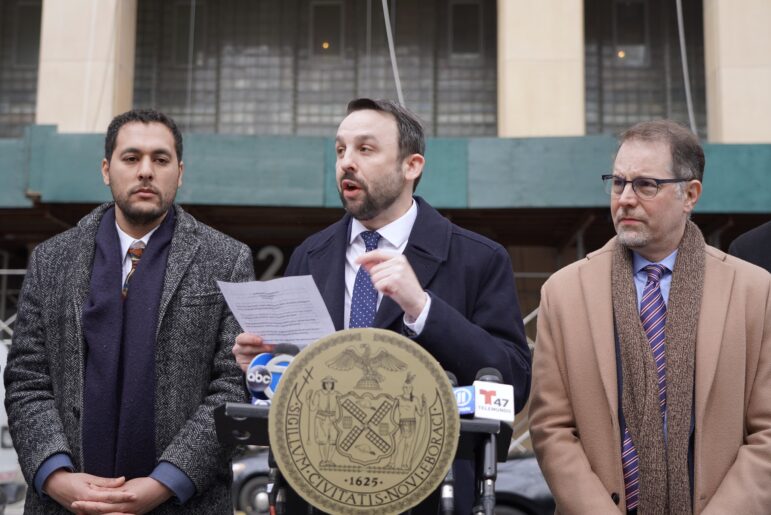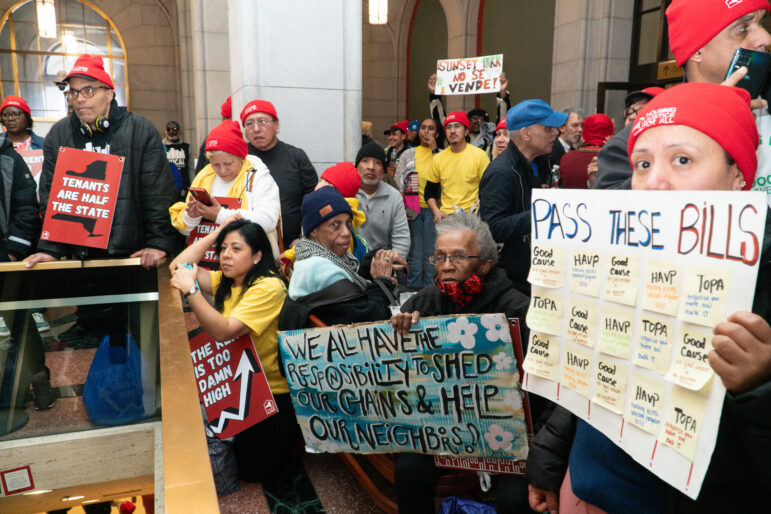
Sadef Kully
Councilmember Ydanis Rodriguez meets with supporters after the Inwood rezoning passes key committee votes.
Hours after the City Council sub-committee on zoning and franchises approved the Inwood rezoning plan, members of Northern Manhattan is Not for Sale and other activists from the Inwood community huddled together planning their sit-in inside Councilman Ydanis Rodriguez’s office just a couple of blocks away.
From all backgrounds and ages, the protestors had organized a list of demands, established protocols in case arrests occurred, planned emergency medical services, packed with food and water and donned comfortable clothing and shoes. They were not preparing to leave.
The Inwood rezoning, the fifth neighborhood rezoning sponsored by the de Blasio administration and a project closely identified with Rodriguez, is inching towards the end of a seven-month public review procedure to approve, amend or reject the mayor’s rezoning proposal. Community Board 12 and Borough President Gale Brewer had said no to the plan while calling for changes. But the Planning Commission approved it in June and Thursday saw key yes votes by the City Council’s subcommittee on zoning and franchises and by the full land-use committee.
Opponents of the Inwood rezoning proposal have expressed concerns about its impact on affordable housing, small businesses, the Inwood library, traffic congestion, culture and quality of life. Although Rodriguez announced significant changes to the plan ahead of Thursday’s Council votes, the protestors were continuing to demand affordable housing at income levels that meet community needs, steps to maintain the neighborhood’s contextual character, a separate land-use process for the library development and clear language on protections for construction workers.
“There is no win today – our neighborhood is still at risk,” said Chris Nickell, an Inwood resident and activist. “We have an important message for Ydanis.”
Protestors reached to the office and asked to meet with the Rodriguez, saying they would not leave until the heard their demands. They made themselves comfortable and waited while additional protestors joined them with signs, drums and chanting. The 34th precinct sent NYPD community affairs officers to the scene.
While the protestors sat outside his small office, Rodriguez was on the other side of Inwood celebrating the victory of the rezoning vote and its last-minute negotiations at La Casa Del Mofongo on Nicholas Avenue with a couple dozen supporters.
A vote, and then a voice of dissent
Earlier in the day, the subcommittee on zoning and franchises waited patiently while Rodriguez negotiated the last parts of the Inwood rezoning plan. The subcommittee was scheduled to begin at 9:30 a.m. but Rodriguez was back in Inwood still negotiating until a bit after 10 a.m.
When Rodriguez arrived at City Hall, he announced the “Commercial U” would be taken out of the plan because that large chunk of the rezoning would not work for the Inwood community.
The “Commercial U” was slated to be located along portions of Dyckman Street, Broadway, and 207 Street and the proposal would have increased residential and/or commercial density with mixed-use development which would require affordable housing. It was a sore spot for rezoning skeptics who argued it would displace small businesses and residents.
Rodriguez also added an additional 1,500 units of affordable housing to the plan– bringing its total to 5,000 units– and a form of rent control for small businesses that would be first of its kind, according to Rodriguez, in that “when any developer builds with city subsidies, we will establish commercial rent control for that site for at least 10 years.”
All three elements were major amendments to the rezoning plan.
The subcommittee passed the rezoning plan by a 7-0 vote, with Councilmember Ritchie Torres abstaining and one member absent. Torres and Inez Barron also abstained from the vote of the full land-use committee, which approved the plan by 12-0; six members were absent.
But before the subcommittee session ended, Councilman Francisco Moya delivered a strongly worded statement criticizing the city’s approach to rezonings. While acknowledging that rezonings will be part of the solution to the housing crisis, Moya insisted that more wage rules and safety protections were needed to cover workers involved in constructing new developments after a rezoning, and said a more deliberate effort needed to be made to study the impact of previous rezonings, especially their secondary displacement effects. He demanded City Hall hand over more data on NYCHire so Councilmembers could evaluate how successful it has been at promoting local hiring.
Most important, Moya said, the city’s reliance on mandatory inclusionary housing to create affordable units troubled him. “I believe we need to change the conversation and stop relying on the market to save us.”
He harshly criticized the last-minute negotiations that had delayed the hearing, for which he blamed the mayor’s office. “It’s shameful that the mayor’s office drags negotiations out to the 11th hour, down to the last second. There are thousands of lives dependent on a responsive and responsible government and subjecting their fates to this treatment is an insult to all New Yorkers.”
Later in the day, Moya clarified his statement, saying he was pausingnegotiations with the Mayor’s Office until it creates a task force dedicated to investigating critical issues related to neighborhood rezonings, “This decision is mine alone. I leave it up to the rest of the City Council and the members of the Committee on Land Use and the Subcommittee on Zoning and Franchises to make their own decisions. They are free to continue negotiating with the administration, but they will do so without me.”
The final City Council vote is scheduled for August 8 and then Mayor de Blasio would have the ability to sign or veto the plan.
The deal’s details
The details of the estimated $500 million InwoodNYC Planning initiative revealed Thursday evening focused on creating, creating and preserving over 5,000 affordable housing units in Inwood along with additional investments in parks and waterfront access; small business and workforce; education and economic development; community services; arts and culture; and transportation and infrastructure through several city agencies and community based organizations.
The initiative plans on preserving 2,500 affordable units by financing and safeguarding affordable housing through offering loans and tax incentives to building owners including outreach efforts for programs that help property owners to make repairs and preserve those units and launching the “Landlord Ambassador” pilot program that provides technical assistance to landlords to navigate Department of Housing Preservation and Development financing processes.
Additionally, renovations of two city-owned buildings on 2110 Amsterdam Avenue and 21 Arden Street whose renovations begin in 2019.
The initiative plans on creating 675 permanently affordable units created on private sites through the Mandatory Inclusionary Housing program and an additional 925 affordable apartments on publicly owned sites within the rezoning area. Developments on public land include the Inwood public library, slated to create 175 affordable units above the library; a residential building on a parking lot located on 4095 9th Avenue slated to create 570 units; a new building expected to create 180 to 250 units within NYCHA’s Dyckman Houses, which will include a 25 percent preference to NYCHA residents; and a redevelopment for affordable housing on the Department of Transportation bridge repair facility at West 206 Street.
Additional locations such as Sanitation garage at West 215 Street and a schoolyard on Vermilyea Avenue are being considered for affordable housing development, as is consolidating Con Edison’s six sites between 202 and 205 streets for mixed use development with affordable housing in the Sherman Creek area.
The initiative’s housing protection efforts include the “Neighborhood Pillars” program, where financing is provided for nonprofits to acquire and rehabilitate rent-regulated buildings; “Partners in Preservation,” which is an anti-displacement strategy; and the “Certificate of No Harassment” pilot program that bars landlords with histories of harassment from getting building permits. HPD will also create a tenant anti-harassment unit to investigate construction and maintenance harassment by bad-acting landlords, conduct outreach for the NYC Rent Freeze program for Inwood tenants and open a base office for nonprofit that provides homeless services.
The plan calls for the prioritizing the creation of deeply affordable homes by mixing and matching HPD programs already in place. Housing developments financed by HPD will include at least 10 percent of all homes for families earning less than 30 percent of the Area Median Income (AMI) which is $28,170 for a three person household and an additional 10 percent for families earning at or below 50 percent of AMI which is $46,950 three person household.
Additionally, the plan promises help for community organizations interested in developing affordable housing on underutilized sites; educating property owners about city resources to develop affordable housing; improving access to affordable housing; hiring locally for city-financed housing developments; responsible contracting and labor standards; and opportunities for minority and women-owned business enterprises.
The initiative will invest more than $122 million in open space, including Highbridge Park, construction of Sherman Creek Malecon, restoration of North Cove and rebuilding Monsignor Kett playground for residents from Dyckman Houses.
The plan also addresses infrastructure issues such as improving pedestrian crossings and providing new traffic signals, street lighting, benches, and taking steps to smooth traffic, along intersections at 10 Avenue at 205th, 207th and 218th streets, as well as Dyckman Street and Nagle Avenue. New lighting and other improvements under the 1 train elevated viaduct will remove the barrier to the waterfront. The city plans on monitoring traffic and pedestrian conditions over the next 15 years to ensure impacts are identified and mitigated. Finally, the city plans on creating a comprehensive plan for water and sewer infrastructure, known as a Drainage Plan.
Other initiatives call for increased access to employment opportunities and training programs in the healthcare, technology and construction industry. The plan also will create educational upgrades such as the early and adult education hub at the Inwood library, strengthening STEM K-12 education including the George Washington Educational Campus, upgrade technologies and broadband improvements in the Inwood area. The creation of an Immigrant Research Center is also included, as is a commitment to continue the study of a potential historic district at Park Terrace West.
The protest continued
After 8 p.m. the crowd outside of Rodriguez’s office had grown and was much louder. The office had become much hotter and crowded – someone had also ordered pizza and soda.
Rodriguez arrived into his office surrounded by protestors and cameras in his face. The crowd was displeased and upset but he stood in front of his secretary’s desk to hear their demands and disatisfaction with the rezoning plan.
“It maybe 50 percent of what we want but that 50 percent is your victory. It is also important to celebrate now that the [Commercial U] is out. You fight by heart, other people fight by politics,” Rodriguez said.
This didn’t satisfy Jeanie Dubnow, a member of Community Board 12 who was part of the sit in. She told the Councilmember that the promise of legal assistance to tenants threatened with eviction was cold comfort, given how hard those cases can be for tenants to win. “It is not going to help to have a million lawyers because now we are gonna have all those people who are going to be harassed by their landlord to get them out,” Dubnow said. “If they get them out legally – renters can’t do anything except drag it out. The upzoning will cause market rate people to come in and those private real-estate people are going to get our money in 421-A [tax benefits].”
“Why don’t you vote no and we fight with you for public land? We are ready to fight,” she added. “Thank you very much for what you have done. However, it is just not enough.”
Rodriguez responded, “I can agree we are not completely there. The plan is online – it is in here. We were here until 10 a.m. this morning. It is not perfect. I will keep trying and I encourage you to fight too.”
Rodriguez walked away to crowd chanting “Vote No.”
His negotiations had not been in vain. Taking out the “Commercial U,” the additional 1,500 affordable apartments and the rent support for small businesses brought in measured support from Brewer and Community Board 12. Brewer said in a statement that the amendments were a step forward, though she would like to see additional tenant protections and the acquisition of more sites.
By Friday afternoon, protestors had spent the night in the office while some were outside for moral support. Protesters Ava Farkas and Maria Pena were barricaded in the office and Ayisha Olgivie, member of Community board 12 had been arrested, according to one of the activists and a Facebook video. They had planned for another press conference and a dance party outside of the office.









4 thoughts on “In Council Chambers and a Member’s Office, Voices of Dissent on Inwood Rezoning”
‘…according to Rodriguez, in that “when any developer builds with city subsidies, we will establish commercial rent control for that site for at least 10 years….’
Guaranteeing that no developer in his right mind will add retail to a development.
Pingback: A Toolkit to Fight Displacement in NYC Neighborhoods, Other U.S. Cities – USA Current News
Pingback: – Protests in Inwood Ahead of Council’s Rezoning Vote
Pingback: Building a Different Reality, at Justice Center en el Barrio – Rights Here